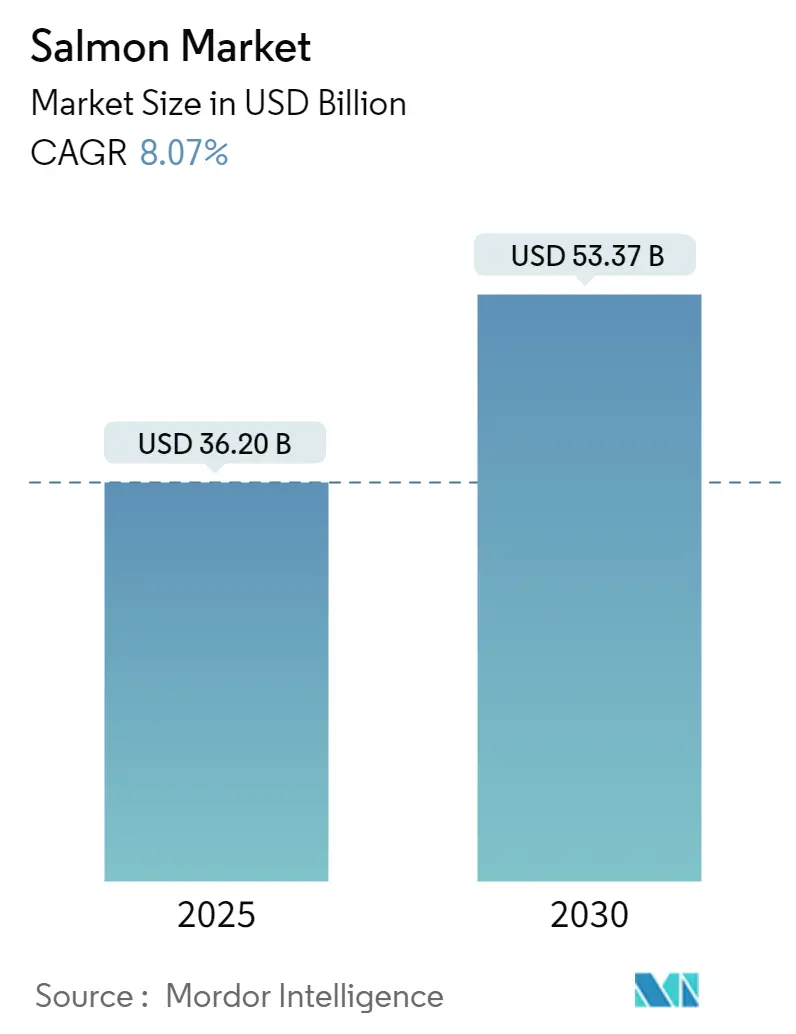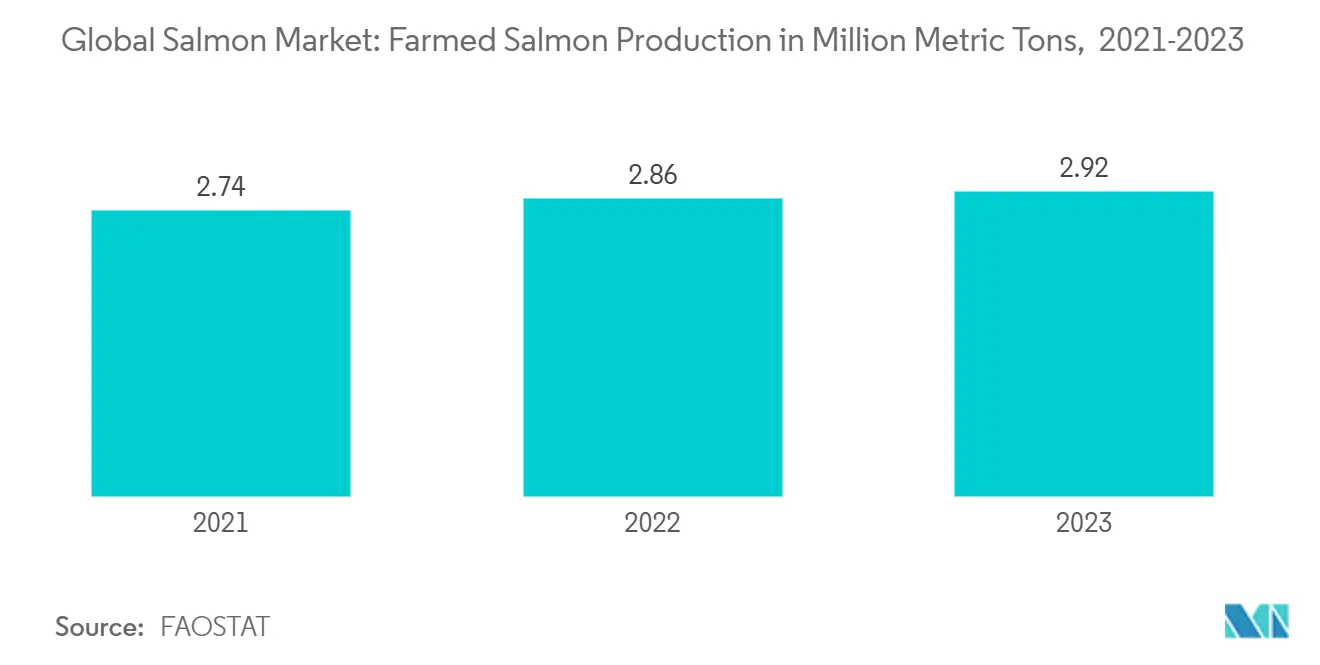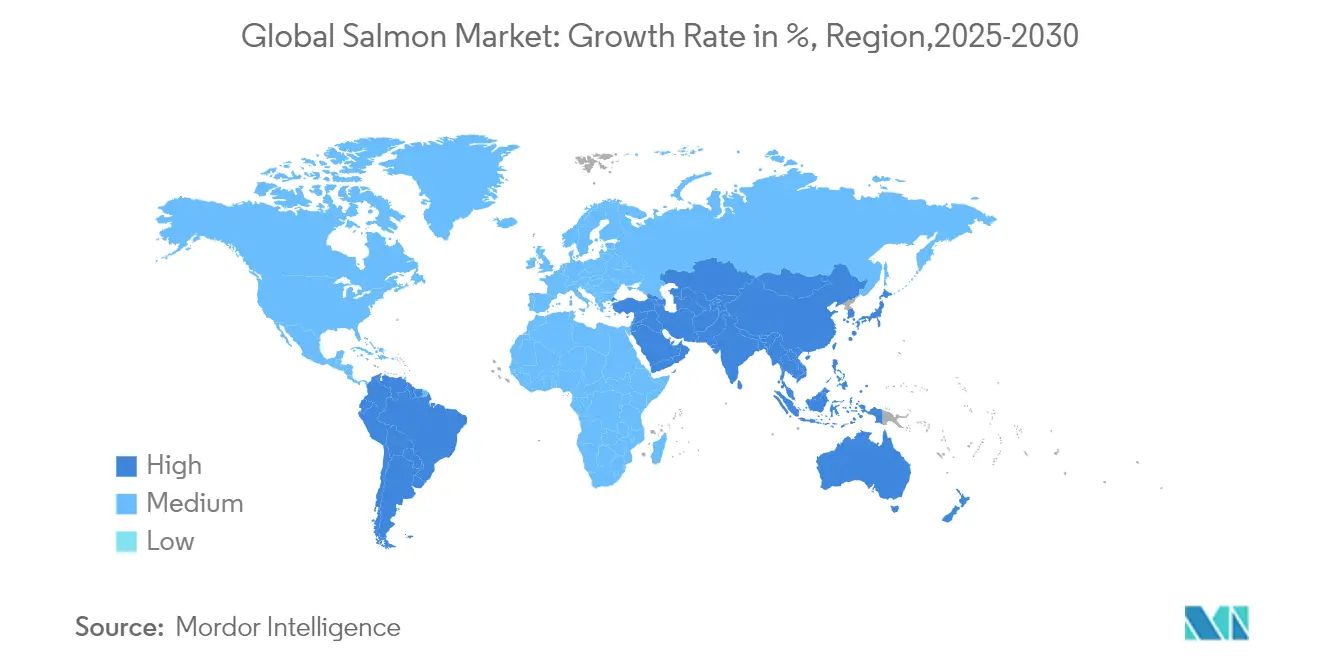Salmon Market Analysis
The Salmon Market size is estimated at USD 36.20 billion in 2025, and is expected to reach USD 53.37 billion by 2030, at a CAGR of 8.07% during the forecast period (2025-2030).
Salmon is often described as an oily fish that is high in protein and omega-3 fatty acids. Many Atlantic salmon found in markets worldwide are raised in farms, while most Pacific salmon are caught in the wild. There are various types of salmon available including chinook, coho, pink, red, Salmo salar, and silver barite. The demand for salmon is boosting globally because of its numerous health advantages including lowering the risk of heart disease, controlling body weight, and promoting bone growth and development.
Traditional salmon farming has been primarily controlled by a few key regions including Chile, Norway, Canada, and Scotland - due to the necessity of specific natural conditions for successful salmon production. These conditions typically include cold water temperatures ranging from 8°C to 14°C, a protected coastline, and optimal biological conditions. In recent times, salmon farming has expanded to Australia, the Faroe Islands, Iceland, Ireland, and New Zealand. In 2022, more than 2.8 million metric tons of farmed salmonoids were produced. In comparison, only around 550,000 metric tons of wild salmonids were caught, with farmed salmon capturing nearly 74% of the overall salmon production in the world. Atlantic salmon is one of the most commonly cultured species of salmon across the world. According to the FAO, overall production of farmed Atlantic salmon was marked at 2,870 thousand metric tons in 2023.
The growing demand for fish in the export market directly relates to producing premium quality salmon fish. Governments and several players in the market are taking various initiatives to boost the fish export market. For instance, in Indonesia, the Program to Increase Fisheries Exports (PROTEKAN) aims to strengthen fisheries exports including salmon. Moreover, many countries are doing trade agreements to boost salmon exports. For instance, as a member of ASEAN, Vietnam is involved in several bilateral and free trade agreements, which created a huge demand for Vietnamese aquaculture products, including salmon, in major economies, such as the United States, North America, China, and India.
Salmon Market Trends
Farmed Salmon is the Largest Growing Segment
Farmed salmon is promoted as a sustainable and eco-friendly source of animal protein to meet the demands of the increasing global population. In 2022, more than 2.8 million metric tons of farmed salmonids were produced. In comparison, FAO estimated that only around 640,000 metric tons of wild salmonids were caught.
Chile's aquaculture sector performance gradually improving over the past few years. This has resulted in increased salmon culture, especially Atlantic salmon culture, which is garnering nearly 74% of the salmon production in the world. Farmed salmon is the country's second-largest export sector after copper mining, generating a total revenue of USD 6.5 billion in 2023, according to the Central Bank of Chile. The bulk of production increase is observed in Chile, at around 11% from 2019 to 2022, where a new regulatory regime produces results. Similarly, in Norway, the world's largest producing country, cold winter, and fish health issues translated into a modest 5% increase in salmon harvests.
Moreover, the supply growth is unable to satiate the salmon demand globally. As demand for salmon continues to strengthen globally, a combination of geographic and regulatory constraints on traditional open-net-pen farming has limited the ability of producers to keep pace. However, increasing investments in salmon production in the Chinese market, coupled with technological approaches such as land and off-shore-based culture and genetically engineered salmon, are some of the potential opportunities for pacing up the production further.
Besides, the salmon farming sector has faced challenges in addressing die-offs, resulting in significant financial losses annually. However, rather than focusing on reducing these losses, the industry has chosen to boost production, resulting in increased profitability. For instance, Norway's Mowi ASA, the largest salmon farming corporation globally, achieved unprecedented profits exceeding USD 1 billion in 2023 alongside record-high production levels.
Chile is the Largest Growing Market
The global supply growth of farmed salmon is led by Chile surpassing the constraints about the mass algal bloom mortalities, thereby maintaining its profitability. Chile accounts for 31% of the world salmon harvest and 22% of Chilean mussel production, according to FAO (Food and Agriculture Organization) figures for 2021. In 2022, 1,000.86 thousand metric tons of salmon were harvested in Chile, as per the Chilean trade body Salmon Chile. In addition, the Chilean Salmon Council, a trade group that includes AquaChile, Australis, Cermaq, Mowi, and Salmones Aysén, together represent more than half of Chilean salmon production by volume.
Salmon is the second most significant exported commodity from Chile after copper, with a large portion of its output being sent to the United States, Brazil, and Japan. The exports of salmon constitute 6.8% of Chile's total exports. In 2022, Chile exported 821,288 metric tons of salmon, amounting to USD 5.361 billion, as the ITC Trade Map reported. Furthermore, in 2024, eleven Chilean salmon producers launched a public-private initiative called "Project Yelcho" to speed up the implementation of vaccines and lower antibiotic usage in salmon farming, while also enhancing environmental conditions.
The Chilean salmon farming sector achieved very promising results. Production costs have fallen, and biological conditions at farms have reportedly improved, reflected in higher harvests that have even surpassed those of Norway. This is particularly driving the efforts to develop new approaches to farming, mainly focused on closed containment technologies, both on land and at sea. Also, new aquaculture operations are being set up in a variety of geographically dispersed countries, such as Iceland, the Russian Federation, and China, which is likely to spike up the salmon supply in the years to come.
Global Salmon Market News
- July 2024: Captain Fresh, a prominent company in the seafood supply chain industry, has acquired Koral, a Polish company that manufactures and distributes branded salmon products. The goal of this acquisition is for Captain Fresh to increase its presence in the global salmon market, which is projected to be worth USD 33.5 billion by 2024.
- March 2024: In Chile, eleven salmon farmers along with the Salmon Council, Salmon Technological Institute (Intesal), and Aquabench, have partnered with the Chilean government's Agricultural and Livestock Service (SAG) and the National Fisheries and Aquaculture Service (Sernapesca) to collaborate on increasing vaccine availability for bacterial disease prevention and decreasing antibiotic usage in salmon farming.
- October 2023: Chile partnered with the Chinese president to export Coho salmon to China. The country is the leading producer of Coho salmon, accounting for approximately 89% of the worldwide production.
Salmon Industry Segmentation
Salmon is a fish species belonging to the family of salmonoids. For the study, both the farmed and captured salmons have been considered for the market estimation. To avoid discrepancy and maintain accuracy, both fresh and processed salmon have been considered for capturing the market trends such as production, imports, exports, and consumption. The salmon market is segmented by Species Type (Atlantic Salmon, Coho Salmon, Masu Salmon, Chinook Salmon, and Other Species Types), Type (Farmed and Wild Captured), and Geography (North America, Europe, Asia-Pacific, South America, and Africa). The study consists of a detailed Production Analysis (Volume), Consumption Analysis (Value and Volume), Import Analysis (Value and Volume), Export Analysis (Value and Volume), and Price Trend Analysis covering all the countries. The report offers market size and forecasts in terms of value (USD) and Volume (Metric Tons) for all the above segments.
| Geography | North America | United States | Production Analysis | |
| Consumption Analysis | ||||
| Import Market Analysis | ||||
| Export Market Analysis | ||||
| Price Trend Analysis | ||||
| Regulatory Framework | ||||
| List of Key Players | ||||
| Logistic and Infrastructure | ||||
| Canada | Production Analysis | |||
| Consumption Analysis | ||||
| Import Market Analysis | ||||
| Export Market Analysis | ||||
| Price Trend Analysis | ||||
| Regulatory Framework | ||||
| List of Key Players | ||||
| Logistic and Infrastructure | ||||
| Europe | Norway | Production Analysis | ||
| Consumption Analysis | ||||
| Import Market Analysis | ||||
| Export Market Analysis | ||||
| Price Trend Analysis | ||||
| Regulatory Framework | ||||
| List of Key Players | ||||
| Logistic and Infrastructure | ||||
| Spain | Production Analysis | |||
| Consumption Analysis | ||||
| Import Market Analysis | ||||
| Export Market Analysis | ||||
| Price Trend Analysis | ||||
| Regulatory Framework | ||||
| List of Key Players | ||||
| Logistic and Infrastructure | ||||
| Netherlands | Production Analysis | |||
| Consumption Analysis | ||||
| Import Market Analysis | ||||
| Export Market Analysis | ||||
| Price Trend Analysis | ||||
| Regulatory Framework | ||||
| List of Key Players | ||||
| Logistic and Infrastructure | ||||
| France | Production Analysis | |||
| Consumption Analysis | ||||
| Import Market Analysis | ||||
| Export Market Analysis | ||||
| Price Trend Analysis | ||||
| Regulatory Framework | ||||
| List of Key Players | ||||
| Logistic and Infrastructure | ||||
| Italy | Production Analysis | |||
| Consumption Analysis | ||||
| Import Market Analysis | ||||
| Export Market Analysis | ||||
| Price Trend Analysis | ||||
| Regulatory Framework | ||||
| List of Key Players | ||||
| Logistic and Infrastructure | ||||
| Greece | Production Analysis | |||
| Consumption Analysis | ||||
| Import Market Analysis | ||||
| Export Market Analysis | ||||
| Price Trend Analysis | ||||
| Regulatory Framework | ||||
| List of Key Players | ||||
| Logistic and Infrastructure | ||||
| United Kingdom | Production Analysis | |||
| Consumption Analysis | ||||
| Import Market Analysis | ||||
| Export Market Analysis | ||||
| Price Trend Analysis | ||||
| Regulatory Framework | ||||
| List of Key Players | ||||
| Logistic and Infrastructure | ||||
| Scotland | Production Analysis | |||
| Consumption Analysis | ||||
| Import Market Analysis | ||||
| Export Market Analysis | ||||
| Price Trend Analysis | ||||
| Regulatory Framework | ||||
| List of Key Players | ||||
| Logistic and Infrastructure | ||||
| Asia-Pacific | China | Production Analysis | ||
| Consumption Analysis | ||||
| Import Market Analysis | ||||
| Export Market Analysis | ||||
| Price Trend Analysis | ||||
| Regulatory Framework | ||||
| List of Key Players | ||||
| Logistic and Infrastructure | ||||
| Japan | Production Analysis | |||
| Consumption Analysis | ||||
| Import Market Analysis | ||||
| Export Market Analysis | ||||
| Price Trend Analysis | ||||
| Regulatory Framework | ||||
| List of Key Players | ||||
| Logistic and Infrastructure | ||||
| Australia | Production Analysis | |||
| Consumption Analysis | ||||
| Import Market Analysis | ||||
| Export Market Analysis | ||||
| Price Trend Analysis | ||||
| Regulatory Framework | ||||
| List of Key Players | ||||
| Logistic and Infrastructure | ||||
| South America | Chile | Production Analysis | ||
| Consumption Analysis | ||||
| Import Market Analysis | ||||
| Export Market Analysis | ||||
| Price Trend Analysis | ||||
| Regulatory Framework | ||||
| List of Key Players | ||||
| Logistic and Infrastructure | ||||
Salmon Market Research Faqs
How big is the Salmon Market?
The Salmon Market size is expected to reach USD 36.20 billion in 2025 and grow at a CAGR of 8.07% to reach USD 53.37 billion by 2030.
What is the current Salmon Market size?
In 2025, the Salmon Market size is expected to reach USD 36.20 billion.
Which is the fastest growing region in Salmon Market?
South America is estimated to grow at the highest CAGR over the forecast period (2025-2030).
Which region has the biggest share in Salmon Market?
In 2025, the Europe accounts for the largest market share in Salmon Market.
What years does this Salmon Market cover, and what was the market size in 2024?
In 2024, the Salmon Market size was estimated at USD 33.28 billion. The report covers the Salmon Market historical market size for years: 2019, 2020, 2021, 2022, 2023 and 2024. The report also forecasts the Salmon Market size for years: 2025, 2026, 2027, 2028, 2029 and 2030.
Our Best Selling Reports
Salmon Industry Report
The salmon industry is witnessing a significant upturn, fueled by an upsurge in health consciousness, innovative product offerings, and an escalating demand for protein-enriched foods. With a wide array of salmon forms available, including fresh, frozen, canned, and freeze-dried options, the market caters to an extensive variety of consumer preferences, emphasizing the nutritional benefits and convenience of salmon products like smoked salmon, salmon oil, and ready-to-eat seafood kits. The industry's growth is particularly notable in emerging markets across Asia and Latin America, alongside traditional markets in the U.S. and Europe. Atlantic salmon leads in market preference due to its availability and nutrient density, whereas Pacific salmon varieties are emerging favorites for their health benefits. The industry benefits from retail partnerships and online sales channels for wider market reach, segmented by species, form, and region to cater to diverse consumer needs, with a focus on sustainable practices and technological advancements to meet the rising global demand. Industry insights by Mordor Intelligence™ highlight the salmon market's projected growth and trends, available for deeper understanding through a complimentary free report PDF download.





